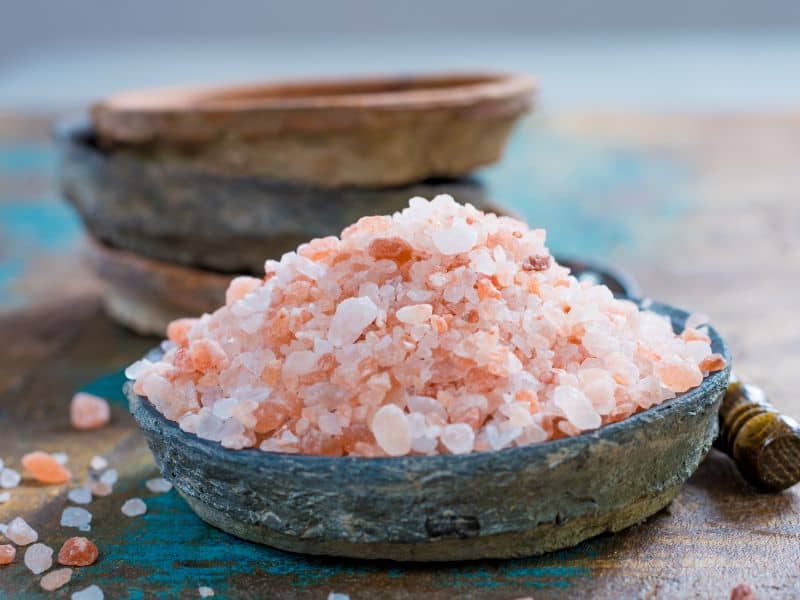Soap-making is an age-old craft that allows for endless creativity, blending art and science to produce luxurious, skin-nourishing products. One secret ingredient that has stood the test of time is salt. You might wonder, why add salt to soap? The answer lies in the remarkable benefits it brings to the soap-making process and the final product.
Salt is added to soap to improve hardness and longevity, enhance cleansing properties, balance skin hydration, and provide aesthetic and sensory appeal. It acts as a thickening agent, natural exfoliant, and fragrance fixative, contributing to a more durable and effective soap.
When added to the soap-making process, salt helps control the rate of trace (thickening) and saponification (soap-making), resulting in a harder bar of soap. In addition, it also helps balance skin hydration, as it is naturally hygroscopic (able to draw moisture from the environment).
Salt As a Vital Ingredient in Soap-Making
Salt has been an essential component in soap-making for centuries. The addition of salt not only enhances the soap’s properties but also contributes to the overall aesthetics and sensory appeal. In this section, we will explore the different types of salt used in soap-making and their importance in the soap-making process.
Types of Salt Used in Soap-Making:
Sea salt
Sea salt, derived from evaporated seawater, is a popular choice in soap-making due to its rich mineral content. The minerals present in sea salt, such as magnesium, potassium, and calcium, contribute to the soap’s nourishing and rejuvenating effects on the skin. Sea salt is often used in exfoliating soaps and spa-inspired bath products.
Table salt
Table salt, also known as sodium chloride, is a common and readily available type of salt used in soap-making. Although it lacks the additional minerals found in sea salt, table salt is an affordable option that effectively hardens and thickens soap. It can also be used to control the lather of the soap, providing a creamy and luxurious experience.
Epsom salt
Epsom salt, or magnesium sulfate, is commonly used in bath products for its soothing and relaxing properties. In soap-making, Epsom salt can be added to create a gentle exfoliating effect, removing dead skin cells and leaving the skin soft and smooth. It is also believed to have anti-inflammatory properties, which can be beneficial for those with sensitive or irritated skin.
Himalayan salt
Himalayan salt, known for its distinct pink hue, is another popular choice in soap-making. Harvested from ancient sea salt deposits in the Himalayan Mountains, this salt contains over 80 trace minerals that can nourish and revitalize the skin. Himalayan salt is often used in exfoliating soaps and artisanal bath products, providing both aesthetic appeal and therapeutic benefits.
Importance of Salt in The Soap-Making Process
The addition of salt to soap serves several purposes, contributing to the overall quality and effectiveness of the final product. Some of the key benefits of adding salt to soap include:
Hardening and thickening
The addition of salt helps to harden and thicken the soap, reducing curing time and resulting in a longer-lasting bar. This is particularly useful for handmade soaps that tend to be softer and more prone to breaking down quickly.
Enhanced cleansing properties
Salt acts as a natural exfoliant, helping to remove dead skin cells and deep-cleanse the pores. This makes salt-infused soaps particularly effective for those with oily or acne-prone skin.
Moisture absorption
Salt is hygroscopic, meaning it attracts and absorbs moisture from its surroundings. This property allows salt-based soaps to help balance the skin’s natural moisture levels, preventing over-drying or excessive oiliness.
Aesthetic and sensory appeal
The use of different types of salt can enhance the texture, appearance, and scent of the soap, adding a unique and luxurious touch to the bathing experience.
Benefits of Adding Salt to Soap
The addition of salt to soap provides a range of benefits, from improving the soap’s durability to enhancing its cleansing properties. In this section, we will explore the key advantages of incorporating salt into your soap-making process.
Thickening and Hardening Agent
Faster drying time
Adding salt to soap can accelerate the drying and curing process. The salt helps to absorb excess water, allowing the soap to harden more quickly. This is particularly useful for handmade soaps, as it reduces the waiting time before the soap can be used or sold.
Longer-lasting soap bars
Salt acts as a hardening agent, resulting in a firmer and more durable soap bar. This not only makes the soap easier to handle but also extends its shelf life. Longer-lasting soap bars are more cost-effective and generate less waste, making them an eco-friendly choice.
Enhanced Cleansing Properties
Salt as a natural exfoliant
One of the main benefits of adding salt to soap is its natural exfoliating properties. The salt granules gently remove dead skin cells, revealing smoother, more radiant skin underneath.
Regular exfoliation can help improve skin texture, reduce the appearance of pores, and promote better absorption of skincare products.
Deep-cleansing effects
Salt-infused soaps are highly effective at deep-cleansing the skin, drawing out impurities and excess oils. The natural antimicrobial properties of salt can also help combat acne-causing bacteria, making salt-based soaps a great choice for those with oily or acne-prone skin.
Moisture Absorption
Salt’s hygroscopic properties
Salt is a hygroscopic substance, meaning it attracts and absorbs moisture from the surrounding environment. When added to soap, this property helps to balance the skin’s natural moisture levels, preventing it from becoming too dry or too oily.
Benefits for skin hydration
Despite its ability to absorb moisture, salt can also help maintain skin hydration. The minerals found in some types of salt, such as sea salt and Himalayan salt, can help strengthen the skin’s natural moisture barrier, locking in hydration and leaving the skin soft and supple.
Aesthetic and Sensory Appeal
Texture and appearance
Incorporating salt into soap can create unique textures and visual appeal.
For example, large salt crystals can add an attractive, rough texture to the surface of the soap, while fine salt granules can be used to create a more subtle, speckled appearance.
The use of colored salts, such as pink Himalayan salt, can also add a touch of natural color to your soap.
Scent retention
Salt can help to prolong the scent of fragrances and essential oils in soap. The salt acts as a fixative, binding the aromatic molecules and slowing their evaporation rate. This results in a longer-lasting, more fragrant soap that provides a more enjoyable sensory experience.
How to Add Salt to Soap
Successfully incorporating salt into your soap-making process requires careful consideration of the type of salt, the timing of its addition, and the appropriate amount. In this section, we will guide you through the process of adding salt to your soap.
Choosing the right type of salt
Selecting the appropriate type of salt for your soap depends on your desired outcome. For general thickening and hardening purposes, table salt is a cost-effective and readily available option.
If you’re looking to add therapeutic benefits or enhance the soap’s sensory appeal, consider using sea salt, Epsom salt, or Himalayan salt.
When to add salt in the soap-making process
The timing of salt addition depends on the specific soap-making method you are using. In the cold process method, dissolve the salt in a small amount of warm water and add it to the soap batter after reaching a light trace.
For the hot process method, add the salt to the soap mixture after the cook and before pouring it into the mold. In melt and pour soap, dissolve the salt in a small amount of water or glycerin, then mix it into the melted soap base.
Determining the right amount of salt
The appropriate amount of salt to use in soap-making can vary depending on the desired outcome and the type of salt being used. Generally, start with a small amount (around 1 teaspoon per pound of oils) and adjust as needed based on the results.
For exfoliating soaps, you may want to use a higher concentration of salt for a more abrasive texture.
Tips for achieving desired soap texture and hardness
- Experiment with different types and grain sizes of salt to find the ideal balance between hardness, texture, and skin benefits.
- Consider combining salts, such as using table salt for hardening and sea salt for added minerals and exfoliation.
- Adjust the amount of salt gradually and keep detailed records of your formulations to fine-tune your soap recipe.
Precautions and Considerations
Incorporating salt into your soap-making process requires some attention to potential pitfalls and concerns. Here are a few things to consider:
Avoiding excessive salt content
Using too much salt in your soap can lead to overly hard, brittle, or crumbly bars that are difficult to use and may cause skin irritation.
Start with a conservative amount of salt and increase gradually until you achieve the desired hardness without compromising the soap’s usability and skin-friendliness.
Allergies and skin sensitivities
While salt can offer numerous skin benefits, some individuals may have sensitivities to certain types of salt or high concentrations of salt.
If you are producing soap for a broad audience, consider offering a range of salt-free or low-salt options for those with sensitive skin or allergies.
Environmental considerations
Salt production and mining can have environmental impacts, such as habitat destruction, water pollution, and resource depletion. When sourcing salt for your soap-making, opt for sustainably harvested or fair-trade options when possible.
Additionally, consider the packaging and shipping of your soap products to minimize plastic waste and carbon emissions.
Frequently Asked Questions
Adding salt to soap can subtly alter its color, particularly if you are using colored salts like pink Himalayan salt. However, the overall effect on the soap’s color will largely depend on the type and concentration of salt used, as well as any other colorants added to the soap.
Avoid using excessive salt content, as it can lead to overly hard or brittle bars. Be mindful of potential allergies and skin sensitivities, and consider offering a range of salt-free or low-salt options for those with sensitive skin.
Salt is hygroscopic, meaning it attracts and absorbs moisture from its surroundings. This property allows salt-based soaps to help balance the skin’s natural moisture levels, preventing over-drying or excessive oiliness.
Salt acts as a thickening and hardening agent in soap, reducing the curing time and resulting in a firmer, longer-lasting bar. This is especially useful for handmade soaps, which tend to be softer and more prone to breaking down quickly.
Yes, salt can enhance the cleansing properties of soap by acting as a natural exfoliant, helping to remove dead skin cells and deep-cleanse the pores. This makes salt-infused soaps particularly effective for those with oily or acne-prone skin.
Conclusion
In conclusion, the addition of salt to soap is a versatile and effective way to enhance various aspects of the final product, from its durability and cleansing properties to its aesthetic and sensory appeal.
By carefully selecting the right type and amount of salt, and considering the timing of its addition, you can create unique, high-quality soaps tailored to a range of skin types and preferences.
It’s essential to remain mindful of potential allergies, skin sensitivities, and environmental considerations when incorporating salt into your soap-making process.






